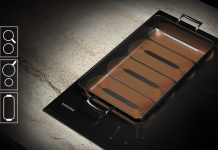 With the designer Wesley Mendez, Whirlpool redesigns the way the oven door opens on the company’s new freestanding range platform: not downward but to the side. What resulted is an optional side-swing door on a new 30-inch freestanding range. Mendez, who is based at Whirlpool Corporation’s Global Consumer Design Offices in Mexico, said the distinctive feature evolved after seeing data indicating a shift in consumer buying behavior in Latin American countries. In response to growing interest in using the oven on a freestanding range and meeting consumers’ changing needs, Mendez said he and his team created a new solution to make the oven cavity more inviting for consumers. “We thought it would be more approachable if we changed the way the door opens – Mendez explained -. Like a refrigerator, when you open the door, it’s a welcome for the consumer. You can get really close and you can have complete control of what happens in the rack”. The challenge of redesigning the oven door was then posed to Whirlpool Corporation’s Global Product Development team. “We had to translate a high-level concept to a manufacturable design”, said Ramiro Ruthes, Whirlpool Corporation System Integrator Leader for Freestanding Ranges. He led fellow engineers in the construction of a new door that is able to swing more than 100 degrees from the opening of the cavity. He explained the door also includes a step on the hinge to hold it clear of consumers while they’re accessing the oven. “One of the main requirements was to develop the side-swing door using the same product platform and most of the parts of the current drop-down door”, Ruthes said. Reengineering the oven door wasn’t the only focus for the Whirlpool teams behind the new freestanding range. They also improved the ergonomics and finishes of the handles and knobs. The burners are more efficient and the grates have been strengthened. Whirlpool introduced the side-swing feature to markets in Mexico in the third quarter 2019. Additional rollout is planned in Peru, Ecuador, and Colombia as well as markets in Central America and the Caribbean in the first quarter 2020.
With the designer Wesley Mendez, Whirlpool redesigns the way the oven door opens on the company’s new freestanding range platform: not downward but to the side. What resulted is an optional side-swing door on a new 30-inch freestanding range. Mendez, who is based at Whirlpool Corporation’s Global Consumer Design Offices in Mexico, said the distinctive feature evolved after seeing data indicating a shift in consumer buying behavior in Latin American countries. In response to growing interest in using the oven on a freestanding range and meeting consumers’ changing needs, Mendez said he and his team created a new solution to make the oven cavity more inviting for consumers. “We thought it would be more approachable if we changed the way the door opens – Mendez explained -. Like a refrigerator, when you open the door, it’s a welcome for the consumer. You can get really close and you can have complete control of what happens in the rack”. The challenge of redesigning the oven door was then posed to Whirlpool Corporation’s Global Product Development team. “We had to translate a high-level concept to a manufacturable design”, said Ramiro Ruthes, Whirlpool Corporation System Integrator Leader for Freestanding Ranges. He led fellow engineers in the construction of a new door that is able to swing more than 100 degrees from the opening of the cavity. He explained the door also includes a step on the hinge to hold it clear of consumers while they’re accessing the oven. “One of the main requirements was to develop the side-swing door using the same product platform and most of the parts of the current drop-down door”, Ruthes said. Reengineering the oven door wasn’t the only focus for the Whirlpool teams behind the new freestanding range. They also improved the ergonomics and finishes of the handles and knobs. The burners are more efficient and the grates have been strengthened. Whirlpool introduced the side-swing feature to markets in Mexico in the third quarter 2019. Additional rollout is planned in Peru, Ecuador, and Colombia as well as markets in Central America and the Caribbean in the first quarter 2020.



